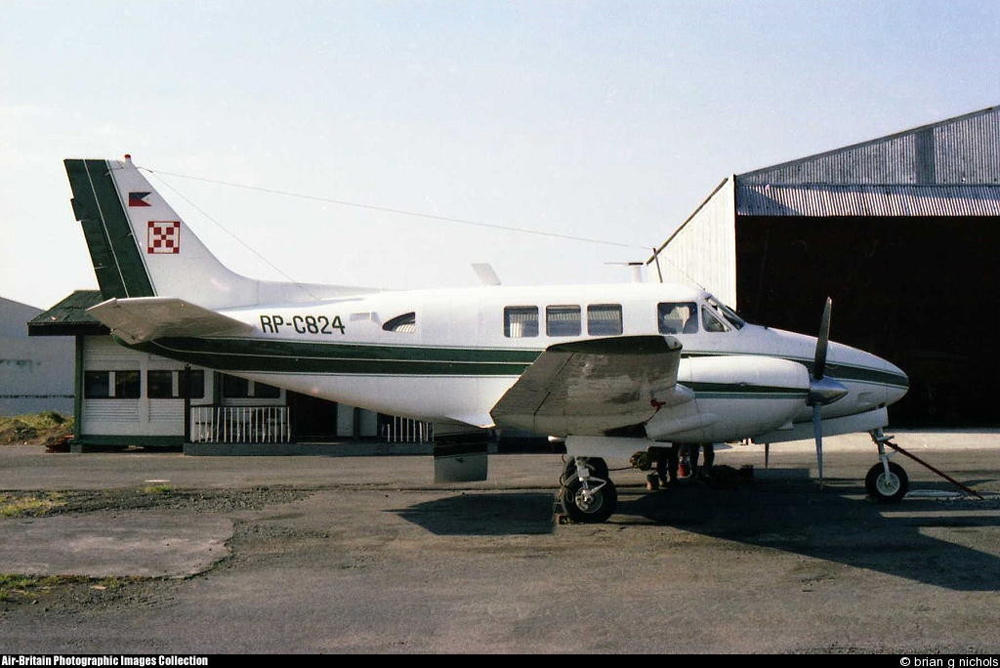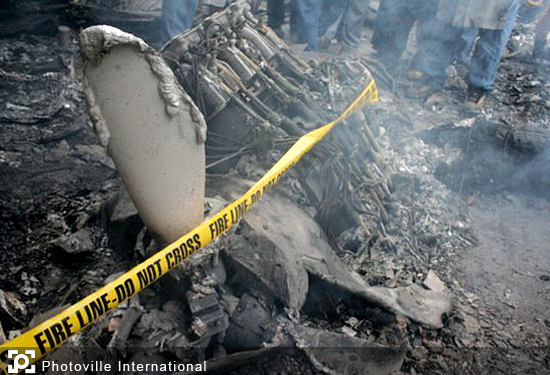Country
Crash of a Beechcraft 65-80 Queen Air in Manila: 13 killed
Date & Time:
Dec 10, 2011 at 1415 LT
Registration:
RP-C824
Survivors:
No
Schedule:
Manila - San Jose
MSN:
LD-21
YOM:
1962
Crew on board:
1
Crew fatalities:
Pax on board:
2
Pax fatalities:
Other fatalities:
Total fatalities:
13
Circumstances:
On December 10, 2011, BE-65-80QA (Queen Air) with Registry RP-C824 took off from RWY 13, Manila Domestic Airport on/or about 0610 UTC (1410H) southbound for San Jose, Mindoro. There were three (3) persons on board, the PIC and two (2) other persons; one was seated at the right-hand cockpit seat and the other one at the passenger seat. After airborne, the ATC gave instructions to the pilot o turn right and report five (5) miles out. After performing the right turn, the pilot requested for a reland which was duly acknowledged but the ATC with instructions to cross behind traffic on short final Rwy 06 (a perpendicular international runway) and to confirm if experiencing difficulty. However, there was no more response from the pilot. From a level flight southward at about 200 feet AGL, three (3) loud sputtering/burst sounds coming from the aircraft were heard (by people on the ground) then the aircraft was observed making a left turn that progressed into a steep bank and roll-over on a dive. After about one complete roll on a dive the aircraft hit ground at point of impact (Coordinates 14.48848 N 121.025811 E), a confined area beside a creek surrounded by shaties where several people were in a huddle. Upon impact, the aircraft exploded and fire immediately spread to surrounding shanties and a nearby elementary school building. The aircraft was almost burned into ashes and several shanties were severely burned by post-crash fire. A total of thirteen (13) persons were fatality injured composed of: the 3 aircraft occupants who died due to non survivable impact and charred by post-crash fire, and ten (10) other persons on the ground, all residents at vicinity of impact point, incurred non-fatal injuries and were rushed to a nearby hospital for medical treatment. About 20 houses near the impact point were completely burnt and the adjacent Elementary School building was severely affected by fire.
Probable cause:
The Aircraft Accident Investigation and Inquiry Board determined that the probable cause of this accident was:
- Immediate Cause:
(1) Pilot’s Lack of event proficiency in emergency procedures for one (1) engine in-operative condition after-off. Pilot Error (Human Factor)
While a one engine in-operative condition during take-off after V1 is a survivable emergency event during training, the pilot failed to effectively maintain aircraft control the aircraft due to inadequate event proficiency.
- Contributing Cause:
(1) Left engine failure during take-off after V1. (Material Factor)
The left engine failed due to oil starvation as indicated by the severely burnt item 7 crankshaft assembly and frozen connecting rods 5 & 6. This triggered the series of events that led to the failure of the pilot to manage a supposedly survivable emergency event.
- Underlying Causes:
(1) Inadequate Pilot Training for Emergency Procedure. Human Factor
Emergency event such as this (one engine inoperative event – twin engine aircraft) was not actually or properly performed (discussed only) in actual training flights/check-ride and neither provided with corresponding psycho-motor training on a simulator. Hence, pilot’s motor skill/judgment recall was not effective (not free-flowing) during actual emergency event.
(2) Inadequate engine overhaul capability of AMO. Human Factor
There was no document to prove that engine parts scheduled to be overhauled aboard were complied with or included in the overhaul activity. The presence unauthorized welding spot in the left-hand engine per teardown inspection report manifested substandard overhaul activity.
(3) Inadequate regulatory oversight (airworthiness inspection) on the overhaul activity of the AMO (on engine overhaul). Human Factor
The airworthiness inspection on this major maintenance activity (engine overhaul) failed to ensure integrity and quality of replacement parts and work done (presence of welding spots).
(4) Unnecessary Deviation by ATC from the AIP provision on Runway 13 Standard VFR Departure Southbound.
The initiative of the AY+TC for an early right turn southbound after airborne was not in accord with the standard departure in the AIP which provides the safest corridor for takeoff and the ample time to stabilize aircraft parameters in case of a one engine inoperative emergency event for a successful re-land or controlled emergency landing.
- Immediate Cause:
(1) Pilot’s Lack of event proficiency in emergency procedures for one (1) engine in-operative condition after-off. Pilot Error (Human Factor)
While a one engine in-operative condition during take-off after V1 is a survivable emergency event during training, the pilot failed to effectively maintain aircraft control the aircraft due to inadequate event proficiency.
- Contributing Cause:
(1) Left engine failure during take-off after V1. (Material Factor)
The left engine failed due to oil starvation as indicated by the severely burnt item 7 crankshaft assembly and frozen connecting rods 5 & 6. This triggered the series of events that led to the failure of the pilot to manage a supposedly survivable emergency event.
- Underlying Causes:
(1) Inadequate Pilot Training for Emergency Procedure. Human Factor
Emergency event such as this (one engine inoperative event – twin engine aircraft) was not actually or properly performed (discussed only) in actual training flights/check-ride and neither provided with corresponding psycho-motor training on a simulator. Hence, pilot’s motor skill/judgment recall was not effective (not free-flowing) during actual emergency event.
(2) Inadequate engine overhaul capability of AMO. Human Factor
There was no document to prove that engine parts scheduled to be overhauled aboard were complied with or included in the overhaul activity. The presence unauthorized welding spot in the left-hand engine per teardown inspection report manifested substandard overhaul activity.
(3) Inadequate regulatory oversight (airworthiness inspection) on the overhaul activity of the AMO (on engine overhaul). Human Factor
The airworthiness inspection on this major maintenance activity (engine overhaul) failed to ensure integrity and quality of replacement parts and work done (presence of welding spots).
(4) Unnecessary Deviation by ATC from the AIP provision on Runway 13 Standard VFR Departure Southbound.
The initiative of the AY+TC for an early right turn southbound after airborne was not in accord with the standard departure in the AIP which provides the safest corridor for takeoff and the ample time to stabilize aircraft parameters in case of a one engine inoperative emergency event for a successful re-land or controlled emergency landing.
Final Report:




Crash of a Beechcraft 65-A80 Queen Air in Meseta del Guenguel: 10 killed
Date & Time:
May 16, 2005 at 1326 LT
Registration:
CC-CFS
Survivors:
No
Schedule:
Coihaique – Balmaceda – Chile Chico
MSN:
LD-220
YOM:
1965
Crew on board:
1
Crew fatalities:
Pax on board:
9
Pax fatalities:
Other fatalities:
Total fatalities:
10
Captain / Total hours on type:
1235.00
Circumstances:
The twin engine aircraft was completing a charter flight from Coyhaique to Chile Chico with an intermediate stop in Balmaceda where six additional passengers boarded. The airplane departed Balmaceda Airport runway 27 at 1310LT for the second leg to Chile Chico. About 16 minutes into the flight, while cruising in marginal weather conditions, radar contact was lost after the airplane crashed in an uninhabited area. The wreckage was found in the late afternoon in Meseta del Guenguel. The aircraft was totally destroyed and all 10 occupants were killed.
Probable cause:
It is believed that the accident was the consequence of a loss of control following an excessive accumulation of ice on the airplane.
Final Report:
Crash of a Beechcraft B80 Queen Air near Maracaibo
Date & Time:
Mar 29, 2004 at 0805 LT
Registration:
OB-952
Survivors:
Yes
Schedule:
Maracaibo – Boa Vista
MSN:
LD-348
YOM:
1967
Crew on board:
2
Crew fatalities:
Pax on board:
0
Pax fatalities:
Other fatalities:
Total fatalities:
0
Circumstances:
The twin engine aircraft crashed in unknown circumstances in the region of Maracaibo while completing a flight from Maracaibo to Boa Vista. No trace of the crew was found and it is believed that the flight was illegal.
Crash of a Beechcraft 65-B80 Queen Air in Belo Horizonte: 3 killed
Date & Time:
Apr 12, 2000 at 1328 LT
Registration:
PT-KKI
Survivors:
No
Schedule:
Belo Horizonte - Sorocaba
MSN:
LD-483
YOM:
1974
Crew on board:
1
Crew fatalities:
Pax on board:
2
Pax fatalities:
Other fatalities:
Total fatalities:
3
Circumstances:
Shortly after takeoff from Belo Horizonte-Pampulha Airport, while in initial climb, the left engine failed. The pilot lost control of the aircraft that rolled to the left, lost height and crashed onto four houses located in the district of São Bernardo near the airport. The aircraft and four houses were destroyed. All three occupants were killed and two other people on the ground were injured.
Probable cause:
Failure of the left engine that was not lubricated according to published procedures. Inappropriate engine maintenance on part of the operator. Also, it was reported that the pilot's experience on this type of aircraft was insufficient.
Final Report:
Crash of a Beechcraft 65-A80 Queen Air in Valdepeñas
Date & Time:
Jan 9, 1999 at 0920 LT
Registration:
EC-EZN
Survivors:
Yes
Schedule:
Valdepeñas – Alicante
MSN:
LD-205
YOM:
1965
Crew on board:
1
Crew fatalities:
Pax on board:
1
Pax fatalities:
Other fatalities:
Total fatalities:
0
Circumstances:
Shortly after takeoff from Valdepeñas Airport runway 08, while in initial climb, both engines lost power. The pilot elected to make an emergency landing when the aircraft crashed in an open field located 3 km from the airfield. Both occupants escaped uninjured while the aircraft was damaged beyond repair.
Probable cause:
It was determined that both engines stopped simultaneously due to a fuel exhaustion. Investigations revealed that the aircraft remained parked at Valdepeñas Airport for five days without surveillance and it is believed that the fuel was stolen from the tanks. The pilot failed to prepare the flight according to published procedures and failed to realize the tanks were empty before departure. Nevertheless, he reported to the investigators that the fuel gauges were intermittently failing.


Crash of a Beechcraft 65-B80 Queen Air in Brainerd
Date & Time:
Oct 17, 1998 at 0033 LT
Registration:
N138BA
Survivors:
Yes
Schedule:
Minneapolis - Brainerd
MSN:
LD-361
YOM:
1967
Crew on board:
1
Crew fatalities:
Pax on board:
0
Pax fatalities:
Other fatalities:
Total fatalities:
0
Captain / Total hours on type:
1813.00
Aircraft flight hours:
8119
Circumstances:
The pilot said that during the ILS approach he reached a point where he thought he should be seeing the approach lights. He said that he checked the radio to determine if it was on the correct frequency. He said that he realized that the transmit switch was selected to the wrong radio and when he returned his attention to the instruments, he realized that he had allowed the airplane to descend low on the glide path. He said that before he could react, the airplane impacted the terrain.
Probable cause:
The pilot's failure to maintain the proper glidepath and his diversion of attention during a critical phase of flight.
Final Report:




